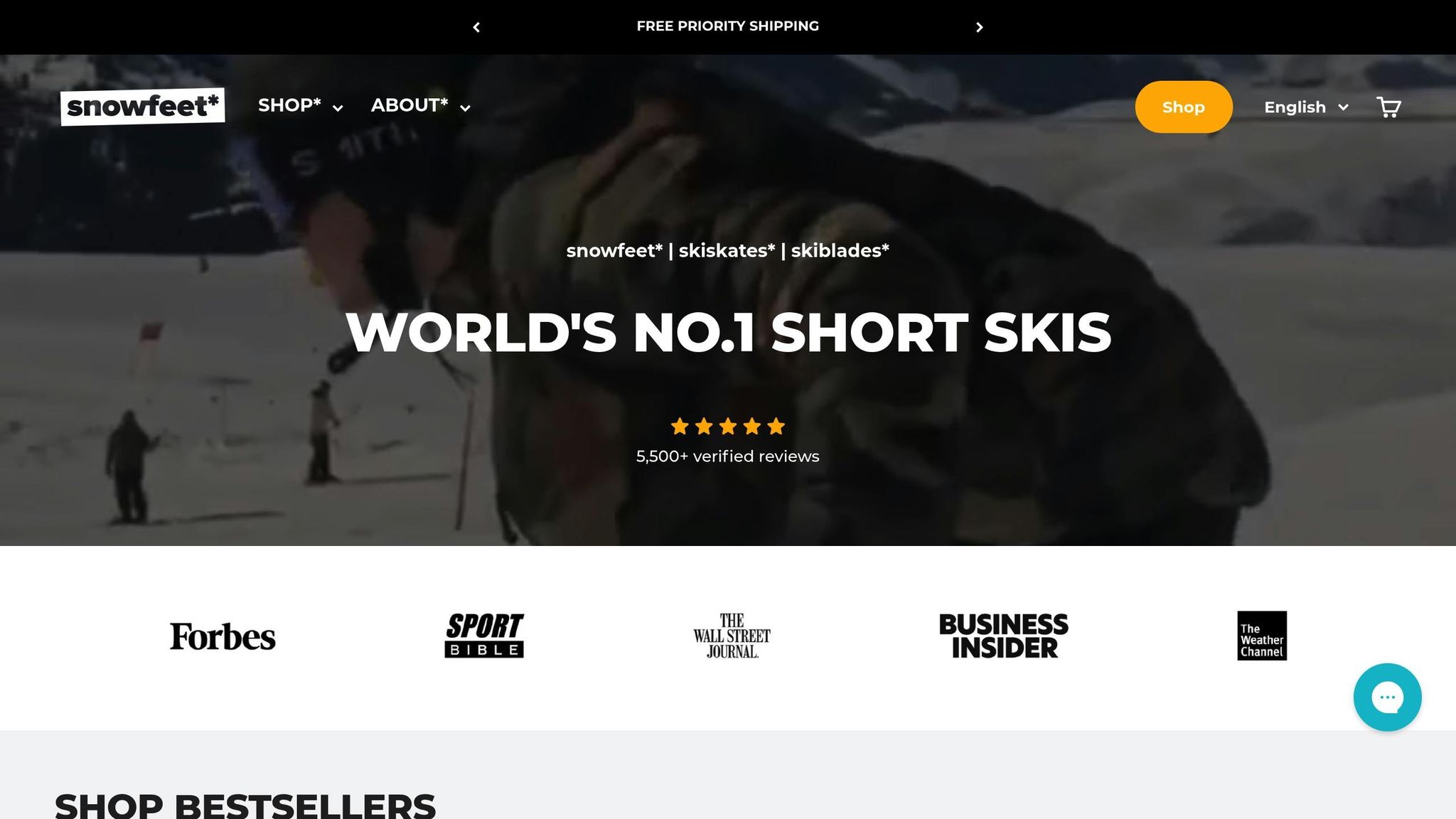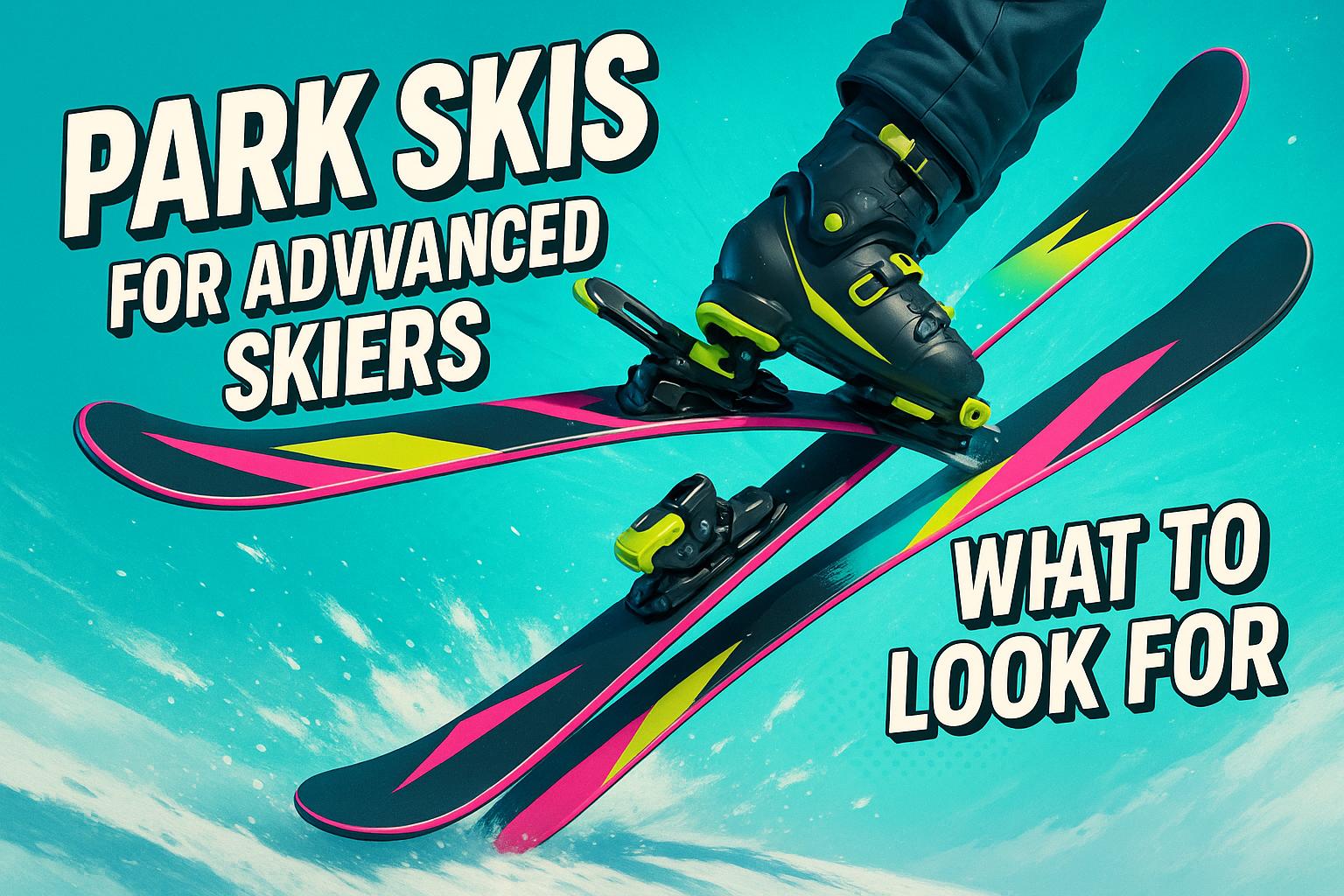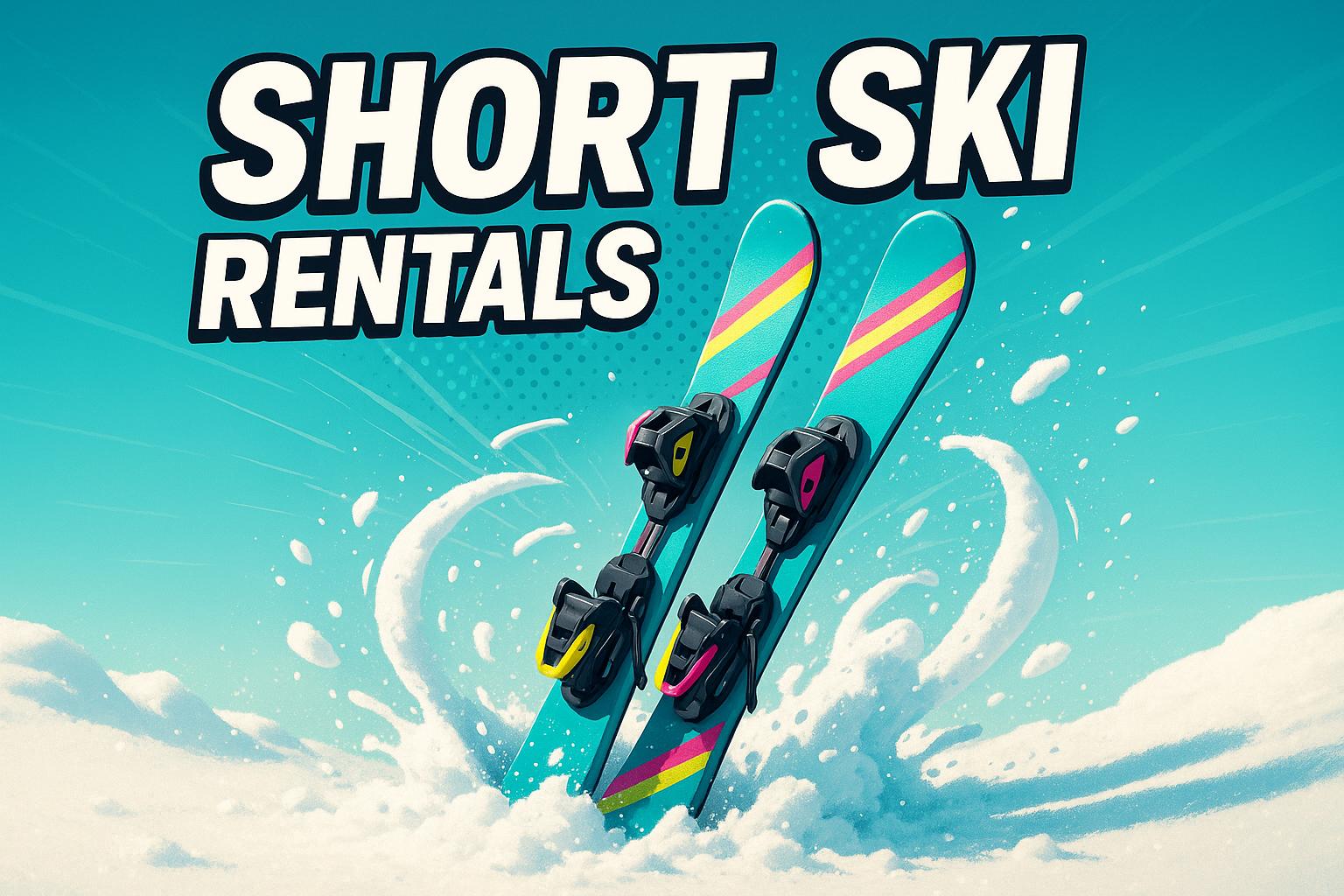Short skis are the key to mastering icy slopes. Their compact size (under 160 cm) offers better grip, sharper edge control, and easier maneuverability compared to traditional long skis. This makes them ideal for quick turns, smooth stops, and navigating unpredictable terrain. Snowfeet*, a leader in short-ski innovation, takes it further with lightweight, portable designs that work with regular winter shoes or ski boots.
Why Choose Short Skis for Ice?
- Better Grip: Smaller surface area focuses weight on edges for stronger traction.
- Easier Maneuverability: Quick turns and pivots for tight or icy spots.
- Lightweight: Less bulk makes recovery from slips easier.
- Convenience: Portable and compatible with everyday winter gear.
Quick Comparison
| Feature | Short Skis (Snowfeet*) | Long Skis (Traditional) |
|---|---|---|
| Turning Ease | Quick, responsive | Requires more effort |
| Grip on Ice | Excellent | Moderate |
| Weight | Lightweight | Heavy |
| Ease of Learning | Beginner-friendly | Steep learning curve |
| Portability | Backpack-friendly | Bulky and hard to carry |
Short skis like Snowfeet* make icy slopes safer, more accessible, and fun. Whether you're a beginner or an expert, they’re a smart choice for winter sports.
Techniques for Stability and Grip on Icy Slopes
Body Positioning for Icy Conditions
When icy slopes turn your favorite run into a slippery challenge, your stance becomes your best defense. Balance is everything here, so let’s start with the basics.
Keep your feet shoulder-width apart, with one foot slightly ahead of the other. Stand upright but not rigid, and shift your weight toward the mid-back of your feet. Slightly bend your knees - this helps absorb shocks and keeps you ready for any unexpected bumps or slips. Think of your legs as your suspension system, always ready to adjust to unpredictable icy terrain.
Once your stance feels solid, it’s time to focus on controlling your edges with precision.
Edge Control with Short Skis
Edge control is your lifeline on icy slopes, and short skis like Snowfeet* require a slightly different approach. Instead of quick, jerky movements, aim for smooth, gradual shifts. Roll onto the edge slowly, tilting your Snowfeet* more sharply than you would with traditional skis. Abrupt motions can break your grip on the ice, so keep it steady.
To stay in control, put more weight on your outside ski. Counterbalance your upper body against your lower body to keep the edge engaged with the icy surface. If you spot softer patches of snow, aim for those - they’ll help keep your edges locked in.
With solid edge control under your belt, you’ll be ready to tackle essential safety moves for navigating icy terrain.
Safety Maneuvers
When ice makes things tricky, having a few reliable safety techniques can make all the difference. Snowfeet* are designed for agility, which makes executing these moves a bit easier.
The "hockey stop" is a go-to move. It works much like it does with regular skis - distribute your weight evenly over both feet, and you’ll come to a smooth stop. For steeper, icier sections, side-slipping is a game-changer. Turn your Snowfeet* perpendicular to the slope’s fall line, then adjust your edge angle to control your descent safely. Need to slow down gradually? That’s where the heel brake comes in handy.
One bonus of Snowfeet* is their compact design, which makes falling a bit less intimidating than with traditional skis. Fewer parts mean fewer chances of injury. If you’re new to this, start on gentler slopes to build confidence before tackling tougher, icier challenges. It’s all about getting comfortable with the basics before leveling up.
Snowfeet* vs. Long Skis on Ice

Performance Comparisons
When it comes to icy slopes, Snowfeet* outshine traditional long skis in several key areas. Their compact design gives them a clear edge when navigating unpredictable and slippery terrain.
One of the standout features of Snowfeet* is their incredible maneuverability. Unlike long skis, which often demand more effort to handle tight turns or twisty paths, Snowfeet* offer agility and quick responsiveness. This makes them a better choice when precision is critical.
Control and stopping power are also areas where Snowfeet* excel. Thanks to their lightweight and flexible build, they allow for fast turns and sudden stops with ease. Traditional long skis, on the other hand, can feel slower to respond during abrupt maneuvers, which can be a challenge on icy surfaces.
Beyond just performance, Snowfeet* add an element of fun to the slopes. While long skis provide a more stable and grounded experience, Snowfeet* bring a playful vibe with their smooth, quick turns and adaptability to changing conditions. As Andrew B. shared after making the switch:
"I will never go back to the original skis."
Nathan F. echoed this sentiment, saying:
"Best fun I've ever had on the snow."
Here’s a quick comparison of how Snowfeet* stack up against traditional long skis:
| Feature | Snowfeet* | Traditional Long Skis (Atomic, Elan, etc.) |
|---|---|---|
| Turning Ease | Quick, responsive turns | Requires more effort |
| Ice Adaptability | Excellent – precise adjustments | Moderate – less responsive |
| Weight | Lightweight and flexible | Heavy and rigid |
| Ease of Learning | Easy for all skill levels | Steep learning curve for beginners |
| Stopping Power | Quick and controlled | Needs more distance and refined technique |
On top of all that, Snowfeet* offer unbeatable convenience and versatility.
Portability and Flexibility
Snowfeet* aren’t just about performance - they’re also incredibly practical. Their lightweight and compact design makes them easy to pack and carry, which is a huge plus when icy conditions force you to move to safer slopes. This portability is a game-changer on tricky winter days.
Another big advantage? You don’t need special ski boots. Snowfeet* work with regular winter or snowboard boots, giving you the flexibility to adapt to changing conditions without being tied to a specific boot system.
Snowfeet* also perform well beyond the groomed slopes. Whether you’re tackling hiking trails or sledding hills, they open up possibilities that traditional long skis might not. Plus, with minimal setup time, you can quickly switch between different terrains without missing a beat.
As Snowfeet* themselves put it:
"Long enough to ski, short enough to skate. Easy to Learn and Use."
In short, when icy conditions make traditional skiing feel like a chore, Snowfeet* step in to deliver a safer, more agile, and - most importantly - more enjoyable experience.
Short Skis vs. Long Skis
sbb-itb-17ade95
Safety Tips for Icy Weather with Snowfeet*
Icy slopes require extra attention to stay safe. Snowfeet* can help you handle these tricky conditions, but preparation and technique are key.
Keeping Sharp Edges
Sharp edges are your best friend on icy slopes. As Tyrolit Life explains:
"Whether you are a professional racer or an avid recreational winter sports enthusiast, sharp ski edges are critical to a fun, safe and successful on-piste experience."
To check your edges, drag a fingernail along them - if it doesn’t scrape, it’s time for a sharpening. Start every season with freshly sharpened edges and don’t wait until they’re completely dull. Use a medium diamond stone to smooth out burrs and keep the edges effective.
For maintaining edges at home, grab a medium or fine grit diamond file and an edge file guide. As one skiing forum user (getdownheavy) points out:
"Minimal, periodic, at-home maintenance will make a world of difference vs just skiing a whole season and doing nothing."
On icy days, sharpen your edges after every session - or at least after hitting rocks or noticing dullness. To avoid catching an edge and falling, use a gummy stone to slightly dull the edges at the tip and tail areas.
Pair these maintenance efforts with a Snowfeet* model designed for icy conditions.
Choosing the Right Snowfeet* Model
The right Snowfeet* model can make a big difference, especially on ice. Here’s how to pick:
- Beginners on ice: The Skiblades 65cm are a solid choice. They offer a mix of control and stability, with a design that maximizes edge contact for better grip on icy patches.
- Experienced riders: Check out the Skiskates (44cm) or Skiblades 99cm. Skiskates (especially the PRO model) excel in speed control on icy surfaces, while the 99cm Skiblades provide extra stability at higher speeds without sacrificing agility.
For the best performance on ice, stick with models that have metal edges. All Skiskates and Skiblades come equipped with durable, European-made metal edges that are built for tough conditions.
If you prefer flexibility, Snowfeet* (38cm and 50cm models) work with regular winter shoes. However, for better ankle support on ice, Skiskates and Skiblades require ski or snowboard boots.
Speed and Turn Control for Ice
Once your edges are sharp and you’ve picked the right model, focus on technique. Adjust your approach to control speed and turns effectively:
- Start by controlling your pace early with techniques that don’t rely too heavily on your edges.
- On ice, skidding is safer than carving. Keep a flatter profile to reduce the chance of slipping.
- When turning, aim for shorter, controlled movements instead of long, sweeping ones. Spread your weight evenly across both Snowfeet* to maintain balance and improve stopping power.
Mark Vizer offers this advice:
"Very gently on your edges. Slice and dice. Like cutting a tomato. Finish each turn. Be patient. Listen for no noise. Be ready for a lot of speed. Relax. If you stiffen up, skis will go sideways. Relax again till they hook up. You'll feel it. Patience, patience, patience."
Don’t forget to wax the base of your Snowfeet* regularly, especially in icy conditions. This prevents snow from sticking and ensures a smooth glide.
If the slopes get too icy, prioritize your safety over performance. Thanks to their shorter length and excellent maneuverability, Snowfeet* give you more control for a safer descent compared to traditional long skis from brands like Atomic or Rossignol.
Handling Weather Changes with Snowfeet*
Mountain weather can flip in an instant - one minute it's icy, the next it’s a powdery dream. While traditional long skis can struggle to keep up, Snowfeet* are built to handle these shifts with ease.
Performance Across Conditions
Snowfeet* shine in unpredictable conditions thanks to their responsive and versatile design. Whether you're gliding over ice or cruising through fresh powder, they deliver consistent performance.
Take Skiblades, for example. Their wide surface area helps you float effortlessly on powder, while their shorter length makes quick turns a breeze when the snow gets deeper. The Snowfeet* PRO (50 cm) goes a step further, offering added balance and stability to handle varying snow depths.
Meanwhile, Skiskates (44 cm) strike the perfect balance between speed and control. With a wood core, they stay steady on icy surfaces while staying nimble in softer snow.
To keep them performing at their best, regular waxing is key. It prevents snow build-up in slushy conditions, ensuring every glide is smooth.
This ability to adapt not only boosts your confidence on mixed terrain but also highlights Snowfeet*'s fresh take on how winter sports gear should perform.
The Future of Skiskating
Snowfeet* is leading a new wave in winter sports with skiskating, a sport that’s all about agility and freedom on snow. This bold approach challenges the long-standing belief that longer skis are always better.
Founders Zbynek and Michael have big dreams for skiskating - they see it one day making its way to the Olympic Games. They’re taking on ski industry giants like Head, Elan, and Atomic, proving that shorter, more versatile equipment can deliver just as much - if not more - fun and performance.
Skiskating feels like skating on snow. It lets you pull off dynamic jumps, twists, and tricks that traditional long skis simply can’t handle. Plus, this skating-like motion makes it easier to adjust to changing snow conditions without relying on the rigid techniques required by longer skis.
Snowfeet* products are also built for versatility. Unlike traditional skis, which are best suited for groomed slopes, Snowfeet* are ready for anything - hiking trails, sledding hills, or even your neighborhood park. That means you can keep enjoying winter sports even when the resorts aren’t in top shape.
Thanks to their shorter length and responsive design, Snowfeet* let you adapt on the fly, so you’re never stuck battling uncooperative gear in unpredictable weather.
Their growing popularity speaks volumes. Models like the Skiblades are earning perfect 5.0/5 ratings, showing that winter sports lovers are ready for a change. And with weather patterns becoming less predictable, having gear that performs across all conditions is more important than ever.
While traditional ski brands remain focused on long skis tailored to specific conditions, Snowfeet* is rewriting the playbook. Their focus on versatility and adaptability makes them the go-to choice for anyone who wants to make the most of the mountains, no matter what the weather decides to do.
Conclusion: Choose Short Skis for Icy Slopes
When it comes to icy slopes, Snowfeet* short skis bring unmatched control, agility, and confidence. Their compact design focuses your weight on a smaller steel edge, giving you a stronger grip on slippery surfaces. While others struggle with bulky long skis in tight spots, you'll be carving sharp turns and stopping with ease.
This isn't just theory - it’s performance you’ll feel on the slopes. Models like the Skiskates (17 inches) and Skiblades (26 inches) are lighter, easier to carry, and offer a freedom that traditional setups just can't match. Say goodbye to clunky poles and oversized skis. With Snowfeet*, you get pure, effortless movement.
While brands like Head, Atomic, and Rossignol stick to the "longer is better" mantra, Snowfeet* founders Zbynek and Michael are flipping the script. Their skiskating innovation focuses on quick reactions, dynamic moves, and versatility. Whether you're a beginner or a seasoned skier, their approach ensures you’ll experience these benefits.
Short skis shine in every scenario - whether you're after solid control and stability or want to nail tricks and jumps. They adapt to changing conditions on the fly and make stopping a breeze. This ability to cater to all skill levels proves why Snowfeet* is the modern choice for icy terrains, turning challenges into pure fun.
When the slopes get slick, traditional setups just can’t keep up. Snowfeet* short skis deliver the agility and control you need to conquer icy conditions. It’s time to leave outdated gear behind and embrace a smarter, sleeker way to ski.
FAQs
How do short skis like Snowfeet* perform on icy slopes compared to traditional long skis?
Short skis, like the ones made by Snowfeet*, shine on icy slopes by offering better agility and control than traditional long skis. Thanks to their compact design, they let you make sharper turns and react more quickly - key advantages when you're trying to stay steady on slippery, icy terrain. Whether you're just starting out or you're a seasoned skier, these skis can make your time on the slopes safer and more enjoyable.
Compared to traditional long skis from brands like Rossignol or Atomic, which can feel bulky and tough to manage in icy conditions, Snowfeet* skis are lightweight and easy to handle. This added maneuverability not only boosts your confidence but also lowers the risk of falls and injuries, making them a practical choice for tackling those tricky winter slopes.
Can I use Snowfeet* with regular winter shoes, and how well do they perform on icy slopes?
Yes, you can use Snowfeet* with your regular winter shoes, as long as they’re waterproof and offer good ankle support. This makes them a super convenient alternative to traditional skis or snowboards, which typically require those big, clunky specialized boots. Thanks to their short and lightweight design, Snowfeet* provide great control and stability - even on icy slopes - making your ride smooth and enjoyable. Unlike the long skis from brands like Rossignol or Atomic, Snowfeet* are much easier to handle and give you more freedom to move, making them a fun, practical option for your winter adventures.
How do I maintain my Snowfeet* for the best performance on icy slopes?
To keep your Snowfeet* in top shape for icy adventures, a little upkeep goes a long way. Start by cleaning the base and edges regularly to get rid of dirt and debris. This helps maintain a smooth glide. Adding a fresh layer of wax to the base is also a smart move - it improves glide and keeps snow from sticking. Don't forget to check the bindings, too. Tighten them up to make sure they're secure, especially if you're tackling tougher terrain.
After each session, wipe off any moisture to prevent rust from forming. When you're done, store your Snowfeet* in a cool, dry spot. These easy steps will keep them ready for action and ensure every ride is as fun and smooth as the last!


































Leave a comment
This site is protected by hCaptcha and the hCaptcha Privacy Policy and Terms of Service apply.